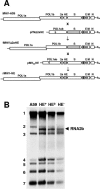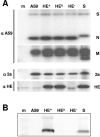Luxury at a cost? Recombinant mouse hepatitis viruses expressing the accessory hemagglutinin esterase protein display reduced fitness in vitro
- PMID: 16306576
- PMCID: PMC1316008
- DOI: 10.1128/JVI.79.24.15054-15063.2005
Luxury at a cost? Recombinant mouse hepatitis viruses expressing the accessory hemagglutinin esterase protein display reduced fitness in vitro
Abstract
Group 2 coronaviruses encode an accessory envelope glycoprotein species, the hemagglutinin esterase (HE), which possesses sialate-O-acetylesterase activity and which, presumably, promotes virus spread and entry in vivo by facilitating reversible virion attachment to O-acetylated sialic acids. While HE may provide a strong selective advantage during natural infection, many laboratory strains of mouse hepatitis virus (MHV) fail to produce the protein. Apparently, their HE genes were inactivated during cell culture adaptation. For this report, we have studied the molecular basis of this phenomenon. By using targeted RNA recombination, we generated isogenic recombinant MHVs which differ exclusively in their expression of HE and produce either the wild-type protein (HE+), an enzymatically inactive HE protein (HE0), or no HE at all. HE expression or the lack thereof did not lead to gross differences in in vitro growth properties. Yet the expression of HE was rapidly lost during serial cell culture passaging. Competition experiments with mixed infections revealed that this was not due to the enzymatic activity: MHVs expressing HE+ or HE0 propagated with equal efficiencies. During the propagation of recombinant MHV-HE+, two types of spontaneous mutants accumulated. One produced an anchorless HE, while the other had a Gly-to-Trp substitution at the predicted C-terminal residue of the HE signal peptide. Neither mutant incorporated HE into virion particles, suggesting that wild-type HE reduces the in vitro propagation efficiency, either at the assembly stage or at a postassembly level. Our findings demonstrate that the expression of "luxury" proteins may come at a fitness penalty. Apparently, under natural conditions the costs of maintaining HE are outweighed by the benefits.
Figures






Similar articles
-
The detection and characterization of multiple hemagglutinin-esterase (HE)-defective viruses in the mouse brain during subacute demyelination induced by mouse hepatitis virus.Virology. 1993 Jan;192(1):170-8. doi: 10.1006/viro.1993.1019. Virology. 1993. PMID: 8390751
-
The hemagglutinin-esterase of mouse hepatitis virus strain S is a sialate-4-O-acetylesterase.J Virol. 1999 Jun;73(6):4721-7. doi: 10.1128/JVI.73.6.4721-4727.1999. J Virol. 1999. PMID: 10233932 Free PMC article.
-
Expression of hemagglutinin esterase protein from recombinant mouse hepatitis virus enhances neurovirulence.J Virol. 2005 Dec;79(24):15064-73. doi: 10.1128/JVI.79.24.15064-15073.2005. J Virol. 2005. PMID: 16306577 Free PMC article.
-
The cellular and molecular pathogenesis of coronaviruses.Lab Anim Sci. 1993 Feb;43(1):15-28. Lab Anim Sci. 1993. PMID: 8384676 Review.
-
[Evolutionary analysis of the hemagglutinin-esterase (HE) gene of influenza C virus].Nihon Rinsho. 1997 Oct;55(10):2627-32. Nihon Rinsho. 1997. PMID: 9360382 Review. Japanese.
Cited by
-
Partial deletion in the spike endodomain of mouse hepatitis virus decreases the cytopathic effect but maintains foreign protein expression in infected cells.J Virol Methods. 2011 Mar;172(1-2):46-53. doi: 10.1016/j.jviromet.2010.12.018. Epub 2010 Dec 28. J Virol Methods. 2011. PMID: 21192978 Free PMC article.
-
The contribution of the cytoplasmic retrieval signal of severe acute respiratory syndrome coronavirus to intracellular accumulation of S proteins and incorporation of S protein into virus-like particles.J Gen Virol. 2016 Aug;97(8):1853-1864. doi: 10.1099/jgv.0.000494. Epub 2016 May 4. J Gen Virol. 2016. PMID: 27145752 Free PMC article.
-
Coronaviruses: An Updated Overview of Their Replication and Pathogenesis.Methods Mol Biol. 2020;2203:1-29. doi: 10.1007/978-1-0716-0900-2_1. Methods Mol Biol. 2020. PMID: 32833200 Free PMC article. Review.
-
Negatively charged residues in the endodomain are critical for specific assembly of spike protein into murine coronavirus.Virology. 2013 Jul 20;442(1):74-81. doi: 10.1016/j.virol.2013.04.001. Epub 2013 Apr 28. Virology. 2013. PMID: 23628137 Free PMC article.
-
Physiologic RNA targets and refined sequence specificity of coronavirus EndoU.RNA. 2020 Dec;26(12):1976-1999. doi: 10.1261/rna.076604.120. Epub 2020 Sep 28. RNA. 2020. PMID: 32989044 Free PMC article.
References
Publication types
MeSH terms
Substances
Associated data
- Actions
LinkOut - more resources
Full Text Sources

